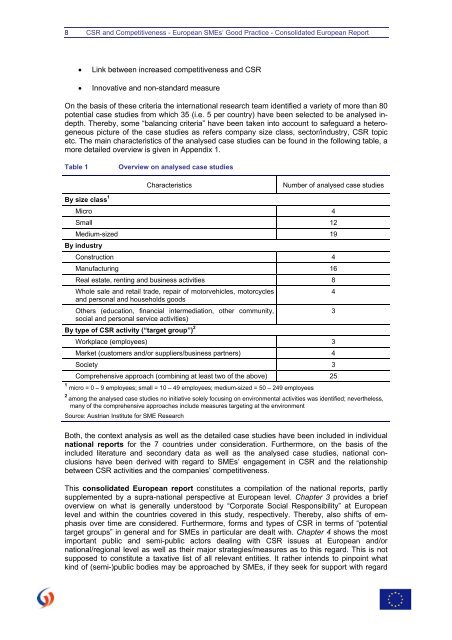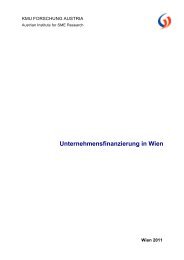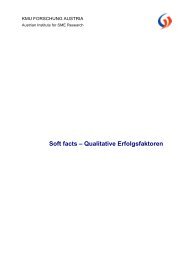CSR and Competitiveness European SMEs - KMU Forschung Austria
CSR and Competitiveness European SMEs - KMU Forschung Austria
CSR and Competitiveness European SMEs - KMU Forschung Austria
Create successful ePaper yourself
Turn your PDF publications into a flip-book with our unique Google optimized e-Paper software.
8 <strong>CSR</strong> <strong>and</strong> <strong>Competitiveness</strong> - <strong>European</strong> <strong>SMEs</strong>’ Good Practice - Consolidated <strong>European</strong> Report<br />
• Link between increased competitiveness <strong>and</strong> <strong>CSR</strong><br />
• Innovative <strong>and</strong> non-st<strong>and</strong>ard measure<br />
On the basis of these criteria the international research team identified a variety of more than 80<br />
potential case studies from which 35 (i.e. 5 per country) have been selected to be analysed indepth.<br />
Thereby, some “balancing criteria” have been taken into account to safeguard a heterogeneous<br />
picture of the case studies as refers company size class, sector/industry, <strong>CSR</strong> topic<br />
etc. The main characteristics of the analysed case studies can be found in the following table, a<br />
more detailed overview is given in Appendix 1.<br />
Table 1 Overview on analysed case studies<br />
Characteristics Number of analysed case studies<br />
By size class 1<br />
Micro 4<br />
Small 12<br />
Medium-sized 19<br />
By industry<br />
Construction 4<br />
Manufacturing 16<br />
Real estate, renting <strong>and</strong> business activities 8<br />
Whole sale <strong>and</strong> retail trade, repair of motorvehicles, motorcycles<br />
<strong>and</strong> personal <strong>and</strong> households goods<br />
Others (education, financial intermediation, other community,<br />
social <strong>and</strong> personal service activities)<br />
By type of <strong>CSR</strong> activity (“target group”) 2<br />
Workplace (employees) 3<br />
Market (customers <strong>and</strong>/or suppliers/business partners) 4<br />
Society 3<br />
Comprehensive approach (combining at least two of the above) 25<br />
1 micro = 0 – 9 employees; small = 10 – 49 employees; medium-sized = 50 – 249 employees<br />
2<br />
among the analysed case studies no initiative solely focusing on environmental activities was identified; nevertheless,<br />
many of the comprehensive approaches include measures targeting at the environment<br />
Source: <strong>Austria</strong>n Institute for SME Research<br />
Both, the context analysis as well as the detailed case studies have been included in individual<br />
national reports for the 7 countries under consideration. Furthermore, on the basis of the<br />
included literature <strong>and</strong> secondary data as well as the analysed case studies, national conclusions<br />
have been derived with regard to <strong>SMEs</strong>’ engagement in <strong>CSR</strong> <strong>and</strong> the relationship<br />
between <strong>CSR</strong> activities <strong>and</strong> the companies’ competitiveness.<br />
This consolidated <strong>European</strong> report constitutes a compilation of the national reports, partly<br />
supplemented by a supra-national perspective at <strong>European</strong> level. Chapter 3 provides a brief<br />
overview on what is generally understood by “Corporate Social Responsibility” at <strong>European</strong><br />
level <strong>and</strong> within the countries covered in this study, respectively. Thereby, also shifts of emphasis<br />
over time are considered. Furthermore, forms <strong>and</strong> types of <strong>CSR</strong> in terms of “potential<br />
target groups” in general <strong>and</strong> for <strong>SMEs</strong> in particular are dealt with. Chapter 4 shows the most<br />
important public <strong>and</strong> semi-public actors dealing with <strong>CSR</strong> issues at <strong>European</strong> <strong>and</strong>/or<br />
national/regional level as well as their major strategies/measures as to this regard. This is not<br />
supposed to constitute a taxative list of all relevant entities. It rather intends to pinpoint what<br />
kind of (semi-)public bodies may be approached by <strong>SMEs</strong>, if they seek for support with regard<br />
4<br />
3




